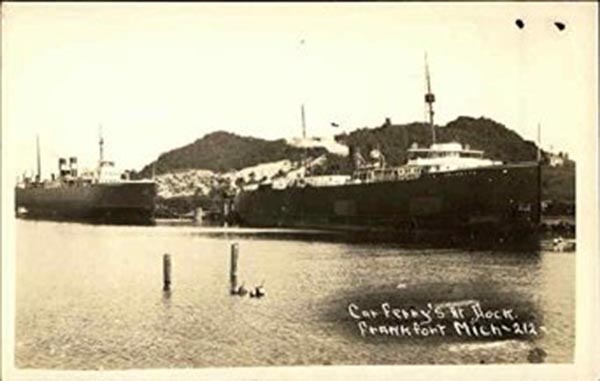The Toledo Ann Arbor & North Michigan railroad arrived in Frankfort, Michigan in 1892. Almost immediately the railroad began a break-bulk service across Lake Michigan to Kewaunee, Wisconsin. The Ann Arbor mimicked the Pere Marquette, its competitor downstate in Ludington, by using a steamship to carry cargo across the lake. The Lackawanna Railroad’s steamer Osceola was leased and carried 35 to 40 carloads of flour across the lake the first season. James Ashley, owner of the Ann Arbor, decided that the cost of shipping using another company’s steamship was prohibitive and he ordered a ferry be built for his railroad.
Ann Arbor Railroad Orders Car Ferries
The railroad’s first ferry, Ann Arbor 1, was built by the Craig Shipbuilding Company of Toledo. The ship was built for lengthy trips across a large stretch of water. The Ann Arbor I was a wooden ferry, with an oak hull, and was built for $260,000. She had four tracks on her deck that allowed her to carry 24 railcars. Before the end of 1892 another ferry, Ann Arbor II, was launched.
Oil to Calm the Heavy Seas
Frequently the ferries would have issues trying to come into the harbor at Frankfort if there was a westerly gale. An innovative, decidedly environmentally unfriendly, idea was to build two pipes that jutted out into the lake about 1,000 feet. The idea was to spread oil to calm the lake surface. Environmentalists did not stop the experiment, however Mother Nature did. Sand kept clogging the pipes and the experiment was discontinued.
Bad Weather and Innovation of the Screw Jacks
While traversing the lake large waves would sometimes knock the railcars off their tracks. The Ann Arbor developed a system of screw jacks and jacking rails, designed to shift the weight of the cars off the tracks. This was done to prevent the car from having independent motion from the ferry. Clams were used to prevent the trucks (wheels) from moving and all the brakes were set. For hopper cars a top hook was also used. Despite all these precautions the Ann Arbor I rolled so violently during a storm in 1895 that 7 railcars broke free and ran off the back of the ferry into the lake.
Menominee and Manitowoc
The year 1894 saw the Ann Arbor expanding service to Menominee, Michigan and in 1896 Manitowoc, Wisconsin was added. The addition of the extra ports required another ferry and the Ann Arbor III was built. By 1906 traffic had increased to the point that the Ann Arbor had to lease two ferries from the Pere Marquette railroad. This led to the building of another ferry the Ann Arbor IV.
Accident and Foul Weather
The Ann Arbor IV had the misfortune of suffering a severe accident not long after entering service. While at the dock she was severely overloaded on one side and sank at the pier. With considerable difficulty she was raised and repaired.
The Ann Arbor I was unlucky in regards to ice. In 1899 the Ann Arbor I became trapped in an ice pack and stayed stuck for 63 days. The same fiasco happened again in 1903, but she was only trapped for a month in that episode. Ice would not be the end of the Ann Arbor I; in1910 she caught fire and was destroyed. The railroad ordered another ferry and this time the new ferry, Ann Arbor V, was designed to be a world-class icebreaker. Two additional ferries came into service during the next fifteen years before the arrival of the Wabash Railroad.
Wabash Railroad Gains Control
The Wabash Railroad gained control of the Ann Arbor in 1925 and ordered what was to become the last addition to the ferry fleet. The newest and last ferry was aptly named the Wabash. In 1958 the Ann Arbor VI was rebuilt and renamed the Arthur Atkinson, in honor of the president of the Wabash Railroad. Today the Arthur Atkinson is moored next to the Spartan in the Ludington harbor.
Wabash Exits and Detroit Toledo and Ironton Enters
The age of mergers saw the Norfolk & Western Railroad take over the Wabash. The Norfolk & Western had no desire to be in the cross-lake ferry business and the Detroit Toledo and Ironton took over the reins of the Ann Arbor Railroad. In 1982, after ninety years of service, the Ann Arbor car ferry service was discontinued.
References:
- Brown, Grant Jr. Ninety Years Crossing Lake Michigan: The History of the Ann Arbor Ferries, University of Michigan. 2008, 296pp
- Hilton, George W. The Great Lakes Car Ferries, Howell-North, Berkeley Ca. 1962, 282pp








